 |
 |
 |
| |
siRNA (JNJ-3989)Plus NRTI and PD-1 Inhibitor Lower But Do Not Clear HBsAg: A phase 2 open-label study to evaluate safety, tolerability, efficacy, and pharmacodynamics of JNJ-73763989, nucleos(t)ide analogs, and a low-dose PD-1 inhibitor in patients with chronic hepatitis B - Interim results of the OCTOPUS-1 study
|
| |
| |
EASL Congress 2024, June 5-8, 2004, Milan
Mark Mascolini
When given with a nucleos(t)ide inhibitor (NRTI) and a PD-1 inhibitor, the small interfering RNA (siRNA) JNJ-3989 sliced HBsAg levels 100-fold in a study of 37 people with virologically suppressed chronic HBV infection [1]. But 24 weeks of treatment with the triple combination did not clear HBsAg, even when participants took extra doses of the PD-1 inhibitor,
A small interfering RNA (siRNA), JNJ-3989 targets all HBV RNAs. Combined with the HBV capsid assembly modulator JNJ-56136379 (nivolumab), JNJ-3989 rarely led to HBsAg clearance in a double-blind, active-controlled, phase 2b trial of 470 adults with chronic HBV infection [2]. But most people treated with JNJ-3989, researchers who conducted this trial proposed, "had clinically meaningful reductions in HBsAg that might contribute to a liver environment conducive to better immune control and, in turn, might improve the response to immune-modulating therapies" [2].
Conducting the new trial, Octopus-1[1], a team from the University of Paris and other centers across the globe suggested countering the immunosuppressive effect of high HBsAg in people with HBV infection by treatment with JNJ-3989 followed by low-dose PD-1 inhibition with nivolumab. They enrolled 37 adults with chronic HBV infection, all of them HBeAg-negative and virologically controlled with NRTIs (all HBV DNA below 60 IU/mL). Participants needed an HBsAg reading between 5 and 10,000 IU/mL and a liver stiffness measure at or below 9 kPa or a METAVIR score of F0 to F2.
All participants received an NRTI plus a JNJ-3989 loading dose of 200 mg subcutaneously once weekly for the first 4 weeks tapered to 200 mg once every 4 weeks until week 24. At week 16 the 18 people randomized to arm 1 received a single intravenous nivolumab dose of 0.3 mg/kg. The 17 people randomized to arm 2 got the same dose at weeks 16, 20, and 24. The primary endpoint was the proportion of participants with HBsAg clearance (below 0.05 IU/mL) 24 weeks after treatment ended.
About 40% of people in each arm had an initial HBsAg level of 100 to 1000 IU/mL. People getting 1 versus 3 nivolumab infusions had a slightly lower proportion of women (16.7% vs 21.1%), younger age (40.67 vs 47.89), and about the same proportions of Asians and whites (about 40% and 60%). Participants came from 10 countries in Europe, Asia, and North America.
At follow-up week 24, no participant had reached the primary endpoint of undetectable HBsAg, but high proportions maintained an HBsAg below 100 IU/mL (at treatment week 24, 89% in the single-dose nivolumab group and 95% in the triple-dose group). After 24 weeks of treatment, HBsAg level fell 2.01 log10 IU/mL in the single-dose group and 2.10 log10 IU/mL in the triple-dose group. After an additional 24 weeks of follow-up, respective HBsAg declines averaged 1.70 and 1.85 log10 IU/mL. Receptor occupancy 2 hours after nivolumab dosing at week 16 exceeded 90% in 29 of 35 participants (83%), with little difference between study arms.
During the 24-week treatment period, 6 people in the single-dose nivolumab group and 12 in the triple-dose group (33.3% vs 63.2%) had 1 or more adverse events. Nonserious adverse events related to JNJ-3989 numbered 2 (11.1%) in the single-dose nivolumab group and 3 (15.8%) in the triple-dose group, while numbers related to nivolumab were 1 (5.6%) and 1 (5.3%). Nivolumab-related thyroid-stimulating hormone suppression led to a protocol amendment that prevented 2 people from getting their third nivolumab dose. The JNJ-3989 loading dose boosted alanine aminotransferase (ALT) moderately from 23 U/L at baseline to 35 U/L at week 8, where ALT stabilized through the end of treatment. Researchers reported no hepatic flares.
The investigators concluded that raising JNJ-3989 dosing frequency during the first 4 weeks of therapy appeared safe and well tolerated but did not help lower HBsAg in this study group. Adding nivolumab doses had no clear benefit and touched off two reversible cases of thyroid-stimulating hormone suppression
References
1. Assalah T, Fung SK, Akhan S, et al. A phase 2 open-label study to evaluate safety, tolerability, efficacy, and pharmacodynamics of JNJ-73763989, nucleos(t)ide analogs, and a low-dose PD-1 inhibitor in patients with chronic hepatitis B - Interim results of the OCTOPUS-1 study. EASL Congress 2024, June 5-8, 2004, Milan. Abstract OS-033.
2. Yuen MF, Asselah T, Jacobson IM, et al. Efficacy and safety of the siRNA JNJ-73763989 and the capsid assembly modulator JNJ-56136379 (bersacapavir) with nucleos(t)ide analogues for the treatment of chronic hepatitis B virus infection (REEF-1): a multicentre, double-blind, active-controlled, randomised, phase 2b trial. Lancet Gastroenterol Hepatol. 2023;8:790-802. https://www.thelancet.com/journals/langas/article/PIIS2468-1253(23)00148-6/abstract#%20
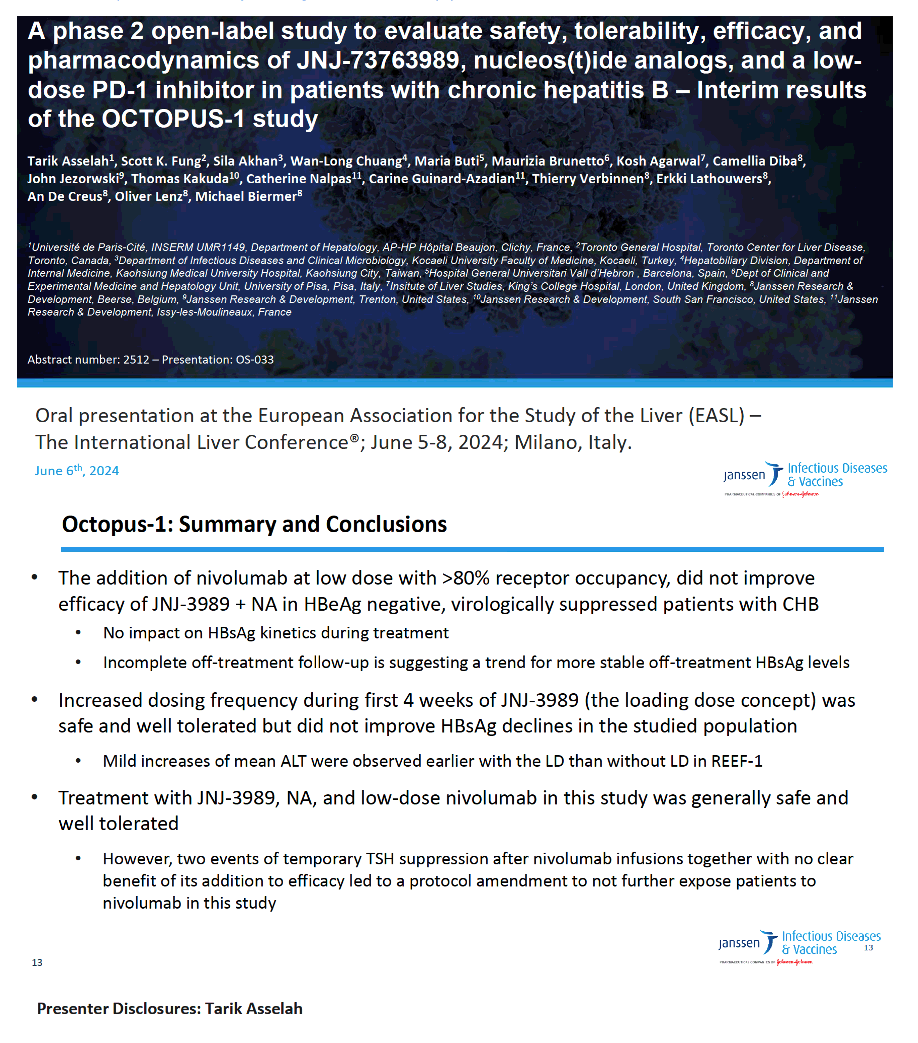
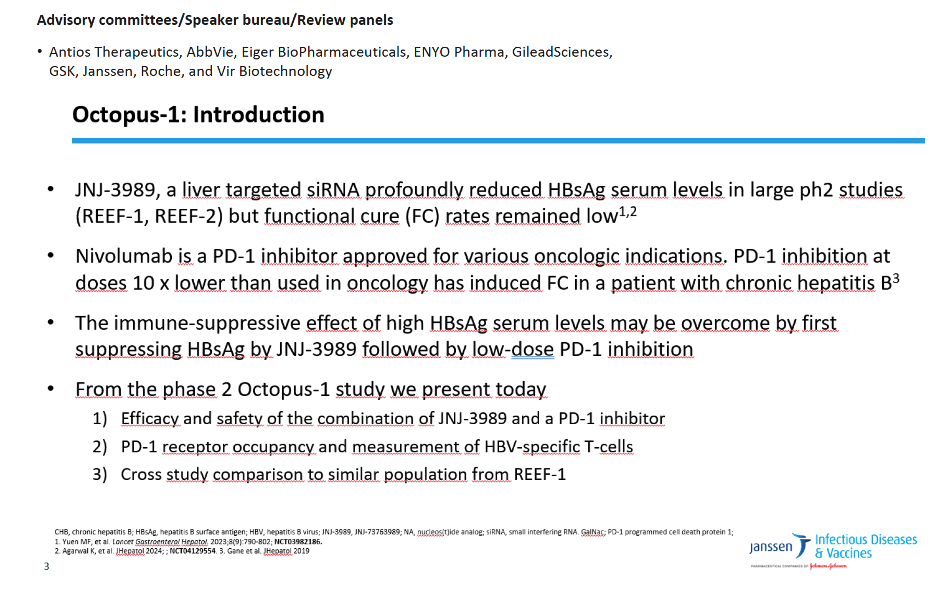
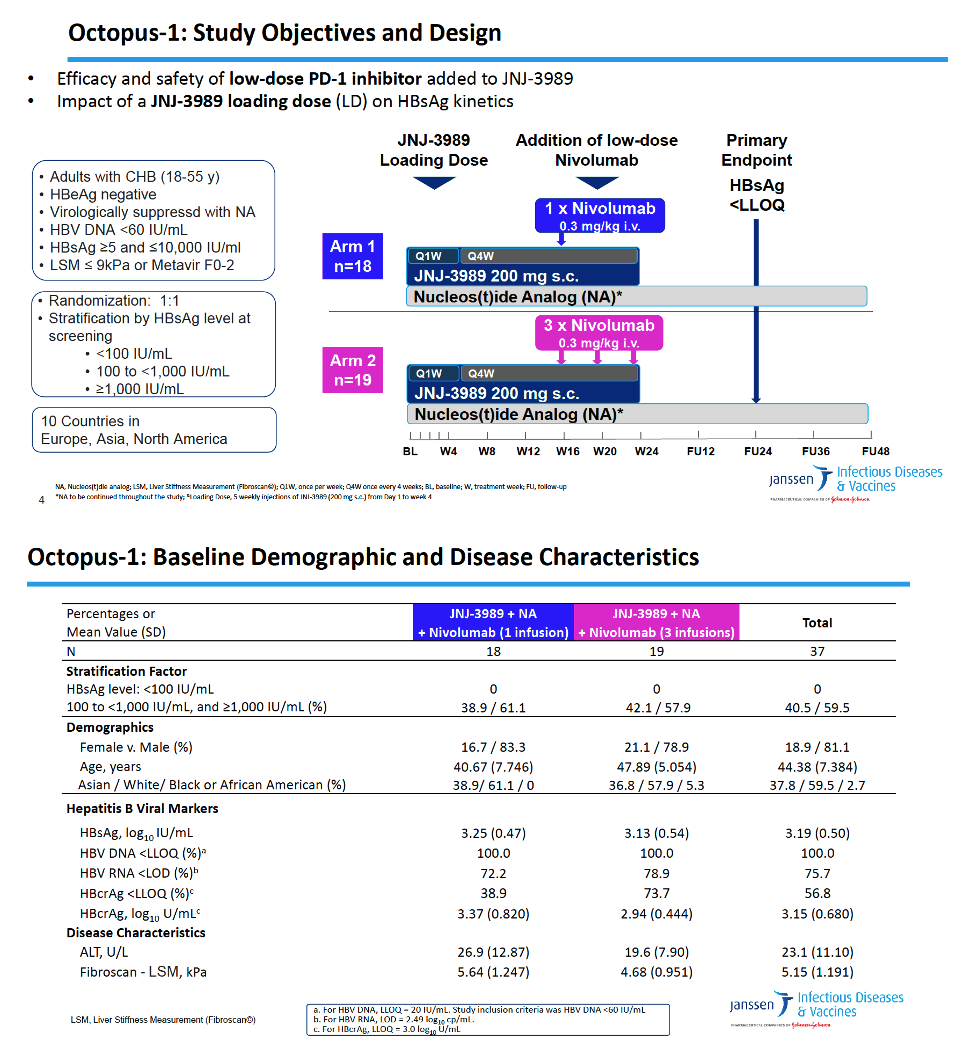
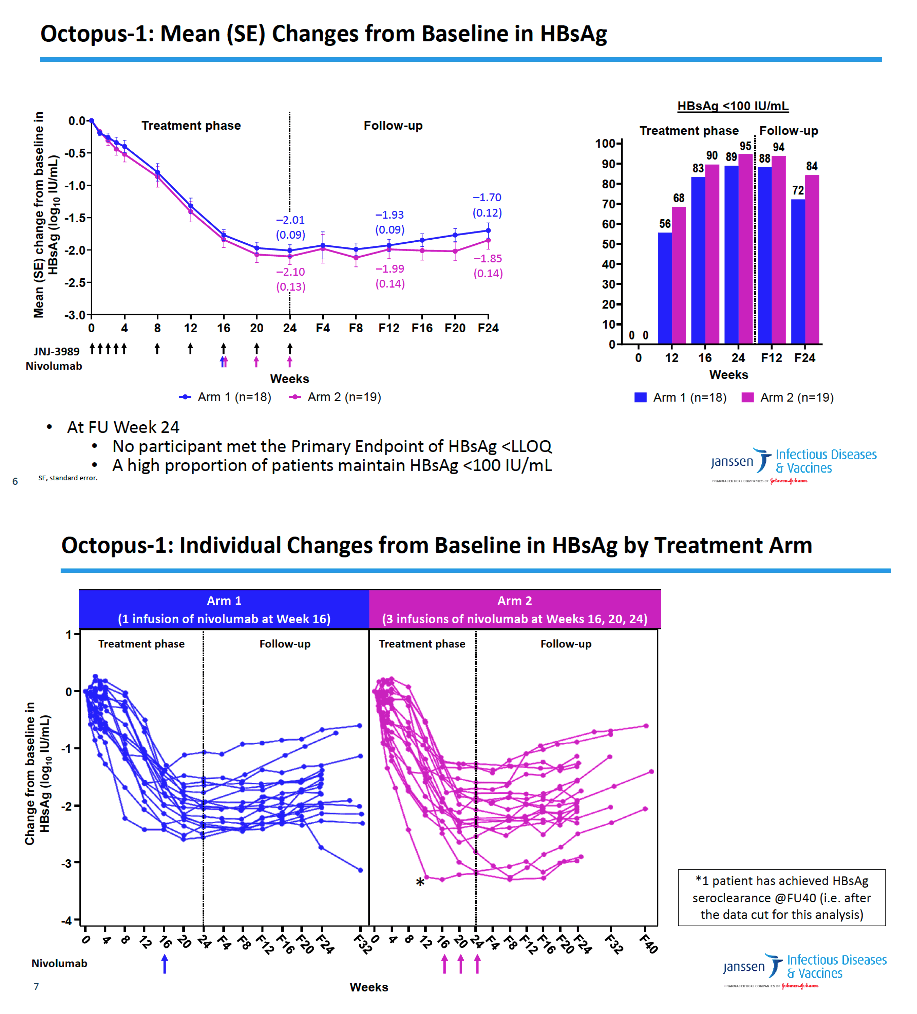

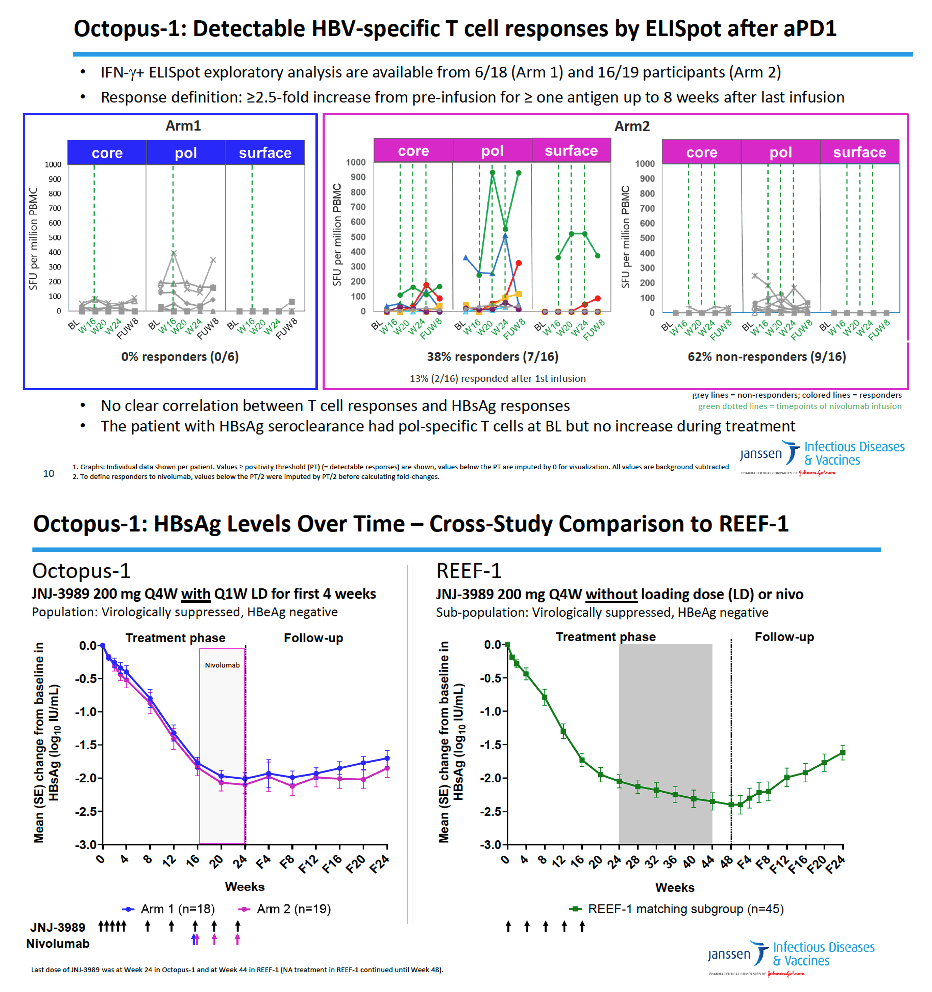
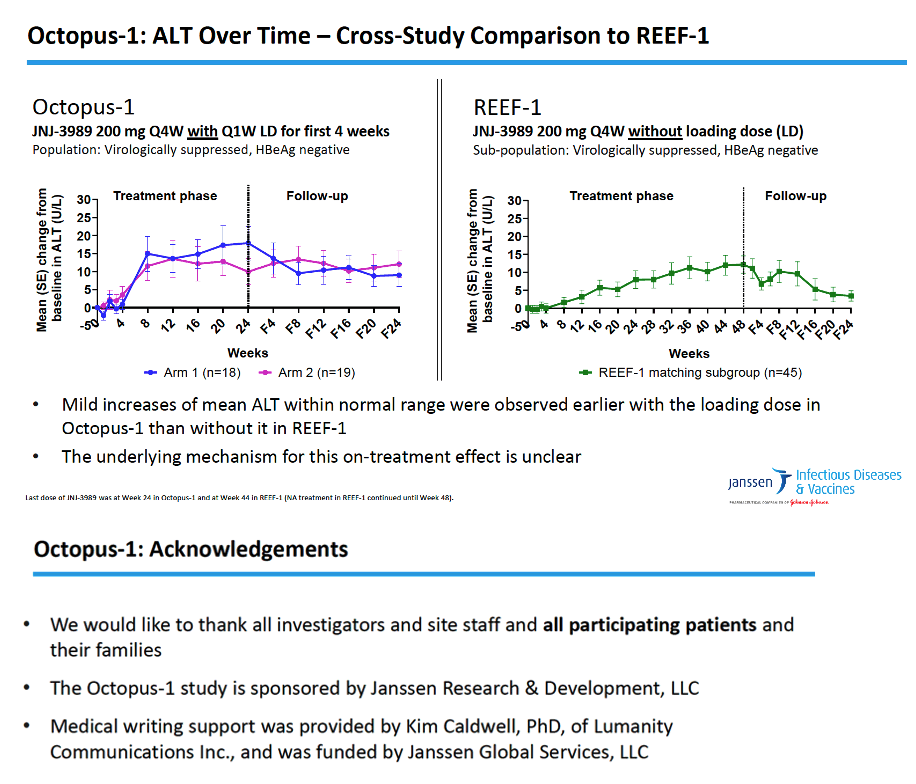
|
| |
|
 |
 |
|
|